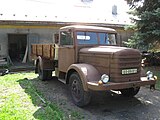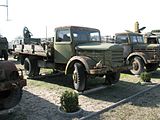Steyr-Daimler-Puch was a large manufacturing conglomerate based in Steyr, Austria, which was broken up in stages between 1987 and 2001. The component parts and operations continued to exist under separate ownership and new names.

Associated Equipment Company (AEC) was a British vehicle manufacturer that built buses, motorcoaches and trucks from 1912 until 1979. The name Associated Equipment Company was hardly ever used; instead, it traded under the AEC and ACLO brands. During World War One, AEC was the most prolific British lorry manufacturer, after building London's buses before the war.

Avia Motors s.r.o. is a Czech automotive manufacturer. Founded in 1919 as an aircraft maker, it diversified into trucks after 1945. As an aircraft maker it was notable for producing biplane fighter aircraft, especially the B-534. Avia ceased aircraft production in 1963.

Csepel, officially known as the 21st District of Budapest is a district and a neighbourhood in Budapest, Hungary. Csepel officially became part of Budapest on 1 January 1950.

Ikarus is a bus manufacturer based in Budapest and Székesfehérvár, Hungary. It was established in 1895 as Imre Uhry's Blacksmith Workshop and Coach Factory(hun.: Uhry Imre Kovács- és Kocsigyártó Üzeme) and during the Communist era in Hungary it dominated bus markets of the entire Eastern Bloc and its allies.
Henry Meadows, usually known simply as Meadows, of Wolverhampton, England were major suppliers of engines and transmissions to the smaller companies in the British motor industry. Founded in 1920 in Park Lane, Wolverhampton, as a car gearbox maker, they expanded into petrol engines in 1922 and in the 1930s built a large factory in Fallings Park, Wolverhampton.

Hellenic Vehicle Industry is a Greek manufacturer of civilian and military vehicles based in Thessaloniki, Greece.

MÁVAG was the largest Hungarian rail vehicle producer. MÁVAG company was the second largest industrial enterprise after the Manfréd Weiss Steel and Metal Works in the Hungarian half of the Austro-Hungarian Monarchy. MÁVAG was the property of the Kingdom of Hungary. After World War II MÁVAG was nationalized, and "Királyi" ("Royal") was removed from its name.

Oy Sisu Auto Ab is a truck manufacturer based in Raseborg, Finland. Its name comes from the Finnish word sisu meaning guts, grit and determination.
Ikarbus a.d. is a Serbian bus manufacturer based in Zemun, Belgrade.
Ferenc Anisits is a Hungarian engineer, engine developer. He founded the BMW Diesel Development Center in Steyr, Austria.

The Maudslay Motor Company was a British vehicle maker based in Coventry. It was founded in 1901 and continued until 1948 when it was taken over by the Associated Equipment Company (AEC) and along with Crossley Motors the new group was renamed Associated Commercial Vehicles (ACV) Ltd.

The D-442 FUG and D-944 PSZH are the results of Hungarian domestic development of relatively cheap amphibious armoured scout car and armored personnel carrier series. FUG and PSZH were exported with limited success, thus it is also known under its Czechoslovak designation OT-65.
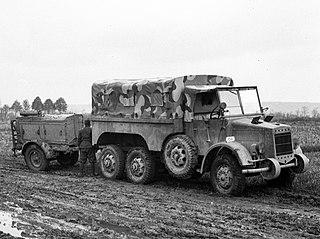
Rába 38M Botond was a Hungarian all-terrain truck. Designed by Győr-based Rába Magyar Vagon- és Gépgyár works, it was extensively used by the Royal Hungarian Army during World War II. The truck was based on a successful Raba AFi truck chassis, but was built in a relatively rare configuration of 6x4. This 1.5 ton lorry was used to ferry both cargo and personnel. There is only one surviving truck, currently in the Transport Museum of Budapest.

Jelcz M11 is a Polish step-entrance city bus manufactured by Jelczańskie Zakłady Samochodowe in Jelcz-Laskowice, near Oława. Manufactured from 1985 to 1990, the Jelcz M11 is a bus with a hybrid design, featuring a modified Jelcz PR110 body combined with the frame and drivetrain of the Ikarus 260.

Hungary significantly decreased the manufacturing of buses but found a large assembly capacities of foreign brands with annual production of more than 800 000 cars.
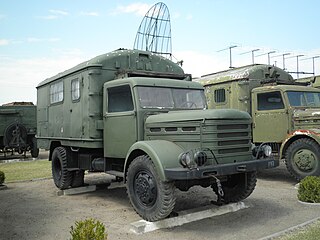
The Csepel D-344 is a medium size, 3-tonne, 4×4 off-road lorry, made by Hungarian manufacturer Csepel Autógyár, from 1961 to 1975. It was first presented to the public on the Leipzig Trade Fair in early 1963. The Hungarian People's Army purchased huge quantities of the D-344, and eventually used it as their standard lorry. It proved to be robust and reliable.
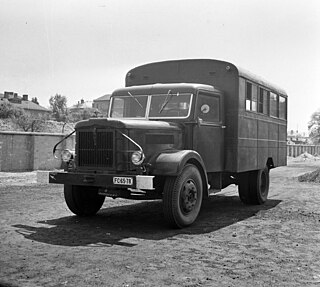
The Csepel D-350 is a lorry made by Hungarian manufacturer Csepel Autógyár from 1950 until 1958. It was the first series production Csepel vehicle, and a copy of the Austrian Steyr 380 lorry, built under licence.
The Hungarian World Bus & DX-Pedition or Globexpedition, also known by the radio call sign HA5BUS and its variations, was a DX-pedition with the aim of traveling around the globe with a bus. The expedition lasted 614 days from 23 October 1991 to 27 June 1993, and its team traveled through or visited places in Hungary, the Soviet Union, Turkey, Iran, Pakistan, India, Bangladesh, Bhutan, Singapore, Australia, the United States, Canada, Germany and Austria. The participants were three Hungarian men, all licensed amateur radio operators; bus driver Gábor Kovács, Volánbusz mechanical engineer István Himberger and Rádiózás magazine's then chief editor Imre Páskuly.




